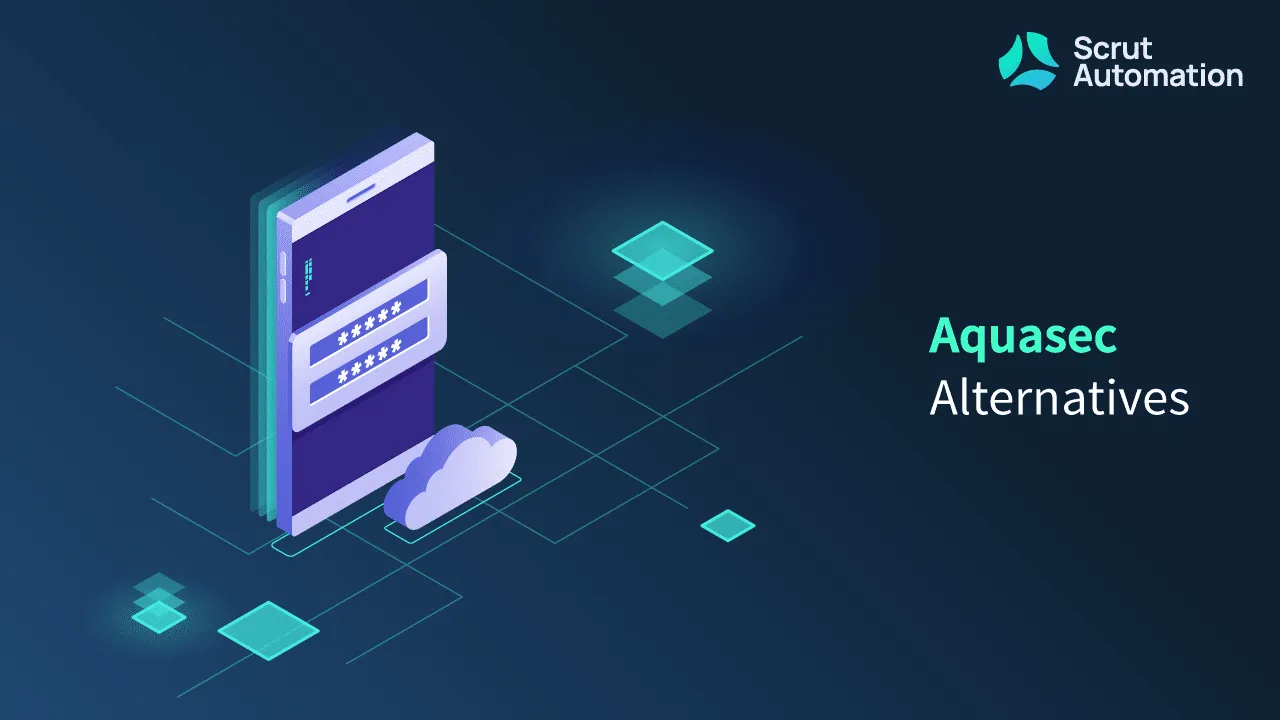5 Best HIPAA Compliance Software in 2025: A Comprehensive Guide

Finding the right HIPAA compliance software is essential for healthcare organizations handling sensitive patient data. Failure to comply with HIPAA regulations can result in fines, legal consequences, and reputational damage, especially in data breaches or improper handling of protected health information (PHI).
Staying on top of HIPAA compliance is no small task. With constantly evolving regulations, secure data handling requirements, and ongoing risk assessments, managing it all manually can quickly become overwhelming. Without automation, organizations often struggle to keep up, leading to inefficiencies, gaps in documentation, and increased exposure to security threats.
The right HIPAA compliance software simplifies compliance, safeguards sensitive data, and makes you audit-ready without much hassle. This guide highlights the top HIPAA compliance software solutions, their key features, and how they help mitigate risks while ensuring patient data security.
Top 5 HIPAA compliance software: An overview
1. Scrut Automation
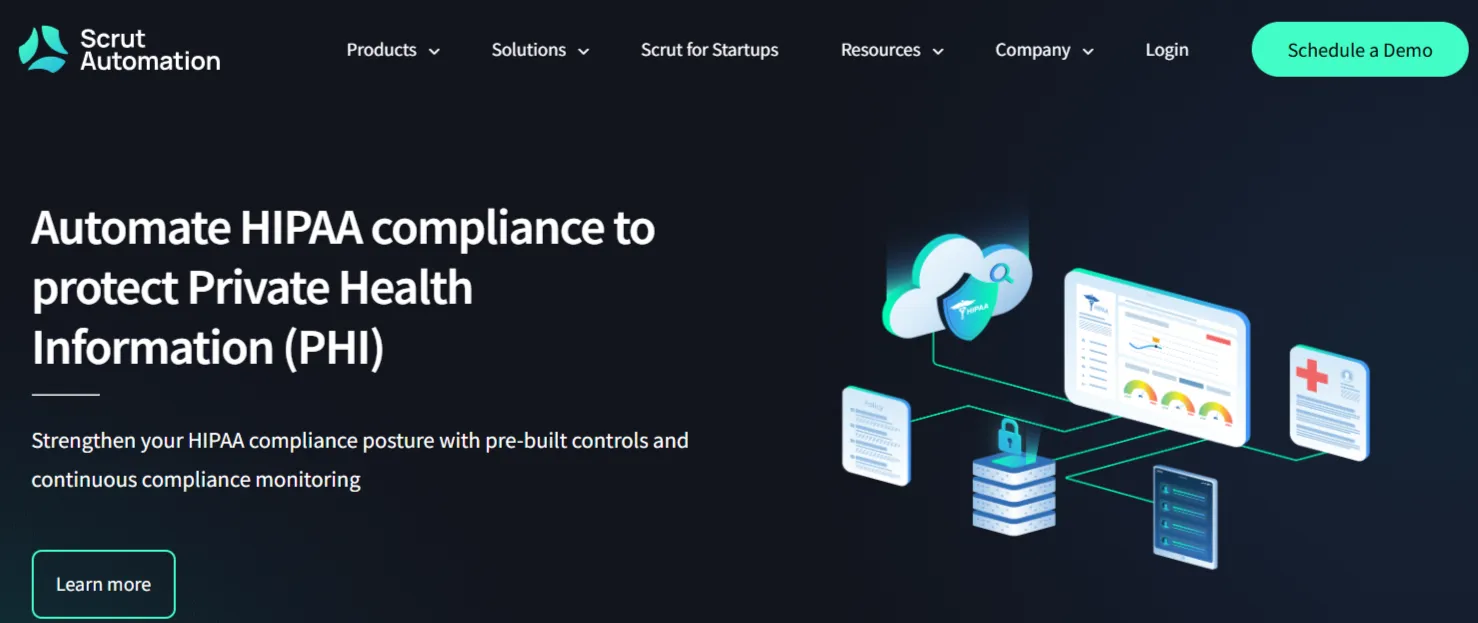
Scrut Automation is a leading compliance automation platform that simplifies HIPAA compliance with end-to-end program implementation support. Featuring 1,400+ pre-mapped controls across 50+ frameworks, 75+ expert-vetted policies, and 80% automated evidence collection, Scrut minimizes manual effort by up to 70%, ensuring seamless HIPAA compliance.
It strengthens HIPAA compliance through automated security control monitoring, proactive risk assessments, and real-time cloud misconfiguration detection. Scrut's integrations with cloud security tools enable organizations to continuously assess their cloud environments for security risks, ensuring compliance with HIPAA's technical safeguards.
Beyond automation, Scrut provides access to a network of HIPAA compliance specialists, including auditors and consultants, who offer expert guidance on security best practices, policy implementation, and audit readiness.
Key features
Comprehensive risk assessment
Scrut helps organizations perform detailed risk assessments and third-party vendor assessments to find any gaps in their compliance. By regularly checking for risks, healthcare organizations can fix problems early, ensuring they comply with HIPAA standards.
Access to in-house compliance experts
HIPAA compliance requires expert guidance at every step. Scrut's team of experienced HIPAA auditors, consultants, and in-house compliance experts provides hands-on support, making the process of end-to-end HIPAA compliance smooth and stress-free.
Scrut's dedicated CSM and infosec team with 50+ years of combined experience guides you through every step of the compliance process.
Implement policies that protect PHI
Scrut provides a library of 75+ expert-vetted policies, or you can upload and customize your own using the built-in editor with version control. The editor allows you to tailor policies to your organization's needs, and Scrut's in-house HIPAA experts can review them to ensure compliance and best practices.
Automate evidence collection
Scrut connects with popular apps, automating evidence collection across your HRIS systems, cloud providers, and IT systems. It automates evidence collection up to almost 80% via continuous automated tests and other types of evidence that can't be automated. They are also logged and tracked in real-time, ensuring you have a 100% audit-ready view of all evidence mapped to the corresponding HIPAA control.
Monitor controls continuously
Scrut streamlines automated control testing by continuously monitoring compliance requirements across policy management, employee training, vendor risk, access control, and cloud security. It automates policy checks every 24 hours, tracks security training completion, ensures timely vendor risk assessments, and flags outdated access rights. Additionally, Scrut scans cloud configurations daily to detect misconfigurations that could lead to compliance failures. Scrut enhances audit readiness across multiple frameworks, including HIPAA and GDPR, by providing real-time visibility into control effectiveness.
Here's a case study of how Cortico achieved HIPAA compliance and saved 800 hours with Scrut.
Cortico, a patient engagement platform, faced complex compliance requirements due to Ontario's updated 2022 guidelines. To address these, Cortico turned to Scrut for a turnkey solution that automated surveillance and certification processes.
Scrut helped Cortico select key certifications, such as SOC 2, ISO 27001:2022, and HIPAA. It also streamlined policy reviews, evidence gathering, and employee training. The automation saved Cortico 800 hours, improved its security posture, and ensured smooth compliance.
As a result, Cortico gained access to larger customers and new markets, bolstering its reputation and operational efficiency. This collaboration transformed compliance from a risk to a resilient, strategic advantage.
Pros
- Scrut offers real-time monitoring of security controls and systems to identify compliance gaps.
- It has a robust HIPAA compliance team and customer support.
- It helps track and maintain HIPAA-related documentation in one centralized platform.
Cons
- Limited customization for highly specific compliance needs
Pricing
Contact us for custom pricing.
2. Sprinto
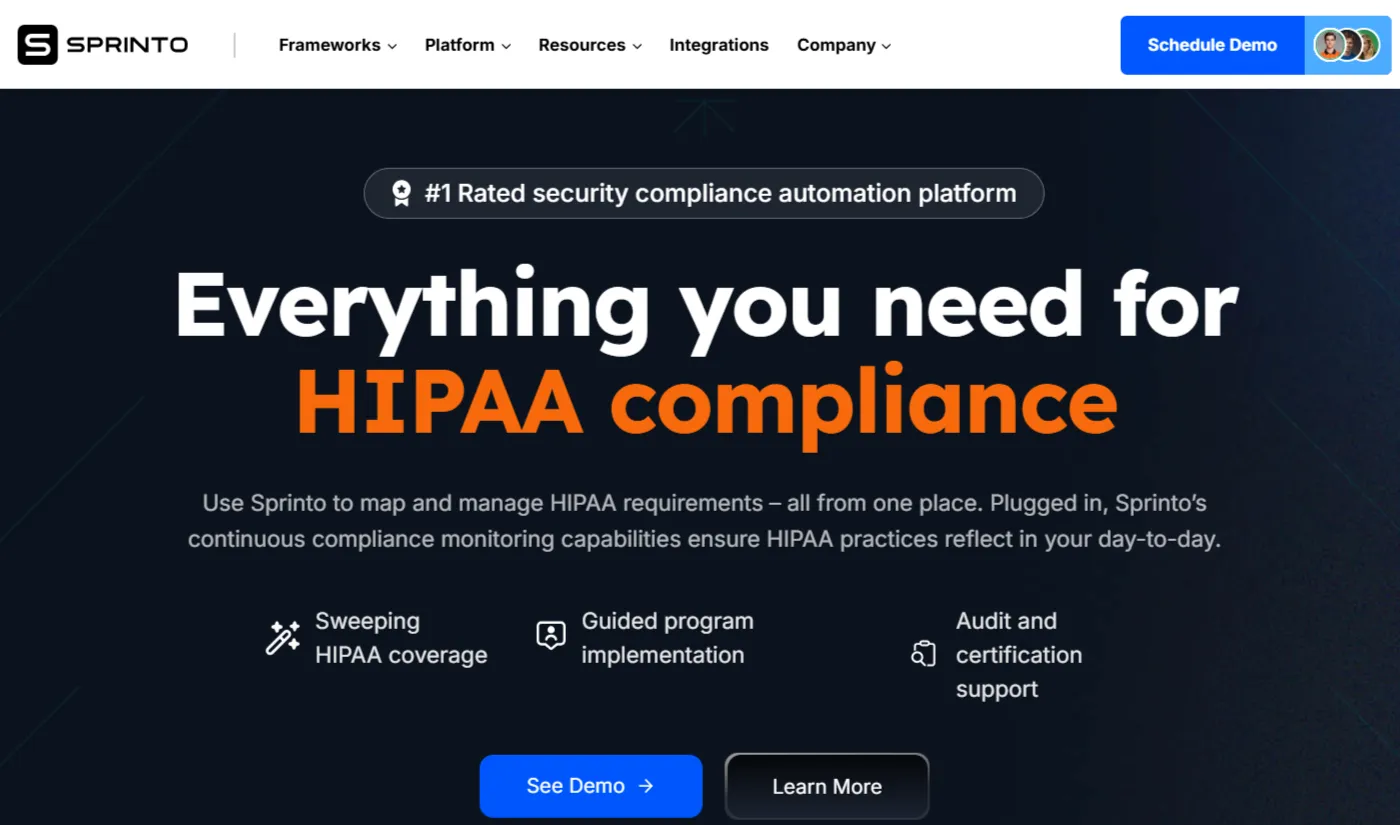
Sprinto is another HIPAA compliance software that helps healthcare companies with continuous monitoring, automated alerts, tailored compliance programs, and automated evidence collection. It supports policy creation and risk management and simplifies audit preparation, making HIPAA compliance more efficient.
Key features
- Policy management: Sprinto helps you create and share HIPAA-compliant policies and processes. It makes managing and tracking policy compliance across your organization easy from one user-friendly dashboard.
- Audit support: It simplifies audit preparation by automating security measures and gathering necessary evidence. It also provides separate internal and external auditors dashboards showing criteria, controls, and asset statuses.
- Automated evidence collection: The tool automates evidence collection by pulling data directly from your systems and integrating with tools like Amazon Web Services (AWS), Google Cloud Platform (GCP), and Azure. This helps gather and monitor data for successful audit certifications.
Pros
- It helps organizations reduce human errors that could lead to compliance violations.
- The platform speeds up the audit process with pre-configured reports that align with HIPAA standards.
Cons
- It has limited customization options.
- The initial setup is complex.
Pricing
Sprinto offers custom pricing. Reach out to their sales or pricing team for a custom quote.
3. Hyperproof
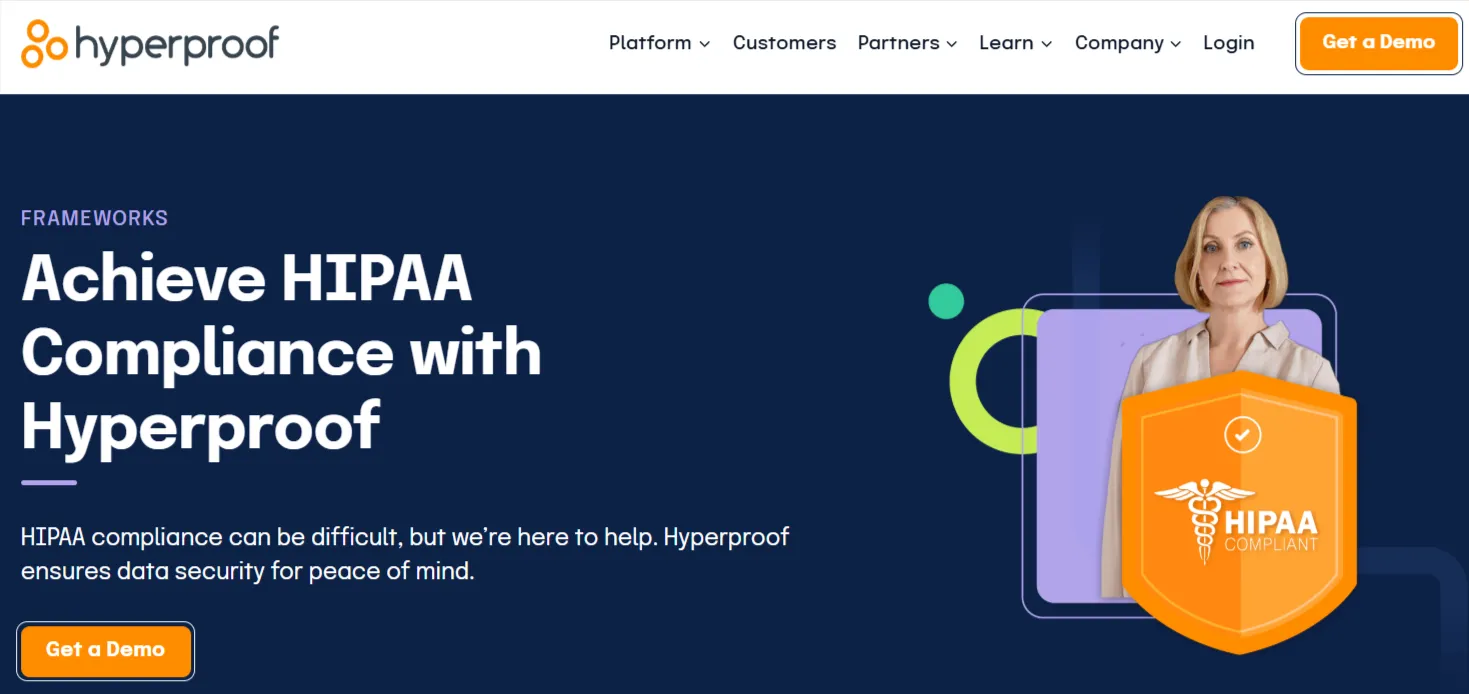
Hyperproof simplifies risk assessments, automates evidence collection, and ensures continuous monitoring of security controls. With intuitive workflows and real-time tracking, Hyperproof enables healthcare providers and business associates to maintain HIPAA compliance efficiently.
Key features
- Integrations: Hyperproof integrates with tools like Slack, Microsoft Teams, Google Drive, and SharePoint to streamline workflows, automate evidence collection, and facilitate continuous monitoring.
- HIPAA program template: It provides a HIPAA template that includes recommended security actions and controls to meet an organization's specific needs.
- Evidence collection: The software automates evidence collection and integrates it with requirements and controls, ensuring that the proof is always up to date.
Pros
- Maintains and organizes all documentation and evidence needed to demonstrate HIPAA compliance.
- Integrates with other business tools, allowing easier data management across systems.
- Provides robust reporting and audit trail features for HIPAA compliance.
Cons
- Lack of built-in approval workflow management capabilities
Pricing
Contact the support team to get details on their pricing.
4. Drata
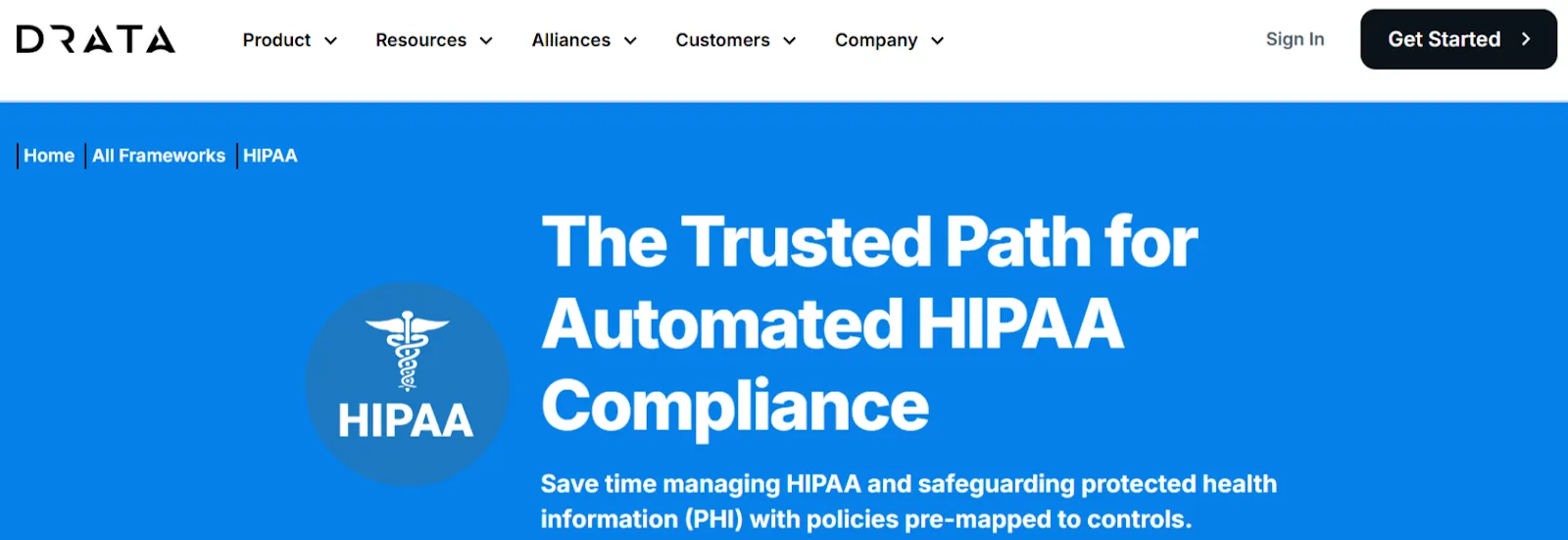
Drata is a HIPAA compliance software that supports compliance by continuously monitoring and collecting evidence of security controls. It automates repetitive tasks, reducing manual effort and errors.
Key features
- Integrations with existing tools: It integrates with cloud services like AWS, identity management platforms like Okta, and version control systems like GitHub, automatically collecting and verifying data across an organization's technology stack.
- Employee training and awareness: Drata tracks and manages employee training, ensuring team members are trained in HIPAA compliance and security best practices.
- Audit-ready reports: Drata can generate reports summarizing an organization's compliance efforts. It also makes preparing for a formal HIPAA audit easier. These reports can include evidence of security controls, policies, risk assessments, and other documentation.
Pros
- It provides built-in HIPAA security training to equip staff.
- It has multiple compliance framework
Cons
- Drata has a complex setup process that can be time-consuming.
- It needs to improve the instructions for fixing the failed/error tests.
Pricing
Drata offers custom pricing. Reach out to their sales or pricing team for a custom quote.
5. Secureframe
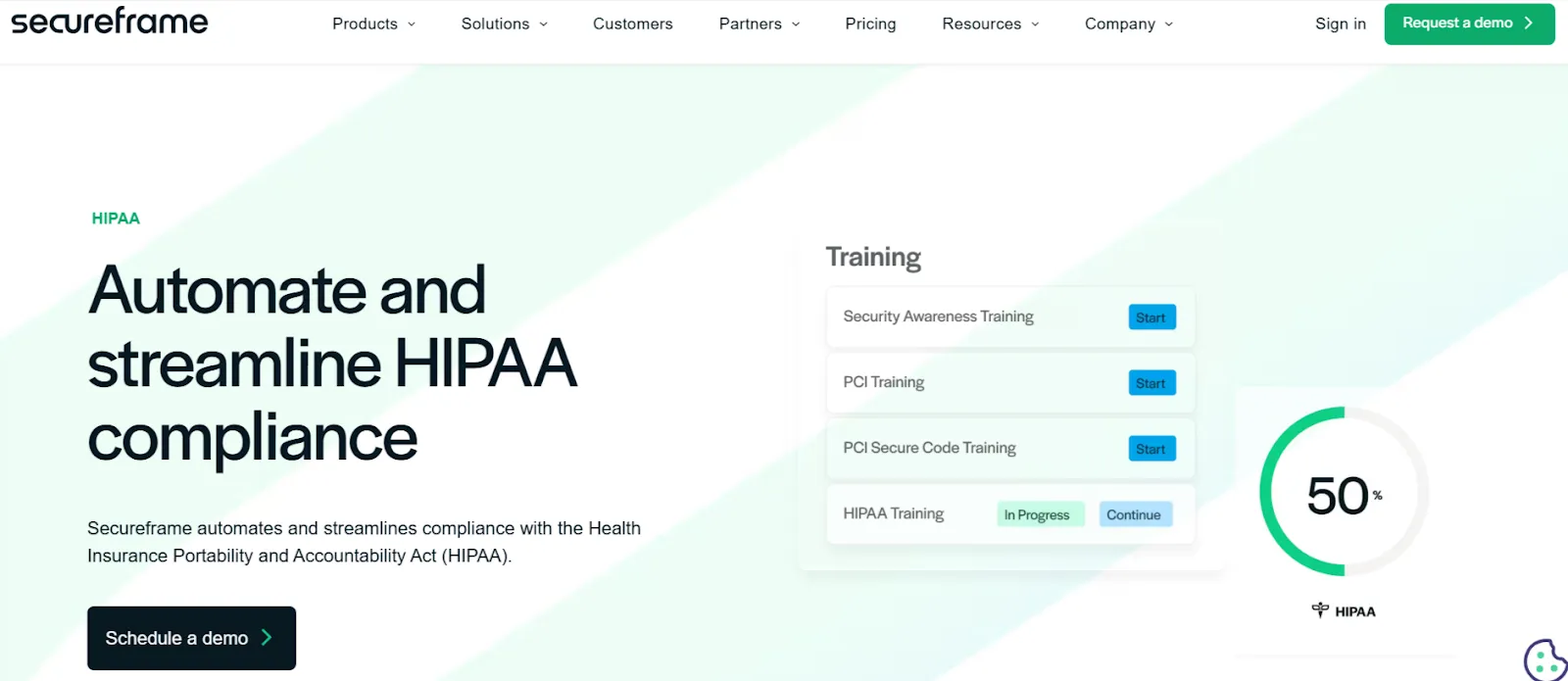
Secureframe is a powerful HIPAA compliance software that automates security and privacy controls for healthcare organizations. It streamlines risk assessments, policy management, and employee training while ensuring continuous monitoring.
With Secureframe, businesses achieve and maintain HIPAA compliance effortlessly, reducing risks and protecting sensitive patient data.
Key Features
- HIPAA policy creation: Secureframe allows the creation of HIPAA-compliant privacy and security policies. It provides a library of policies that can be adapted to an organization's specific needs and published to employees through the platform.
- Employee training: The platform helps organizations track employees' completion of HIPAA privacy and security awareness training via a progress dashboard, including quizzes and policy acceptance. It guides employees through an automated, self-serve training flow.
- Centralized documentation and evidence collection: Secureframe centralizes the documentation and evidence collection process by providing a single repository for storing compliance documents, policies, and audit reports. It integrates with existing tools to gather evidence, such as logs from security systems automatically.
Pros
- It has a simple and user-friendly design, making it easy to use.
- The tool offers ready-to-use HIPAA-compliant policies
Cons
- It focuses on compliance automation but does not replace a full-fledged security management system.
Pricing
Get your customized pricing from their customer support.
Key features to look for in HIPAA compliance software
1. Pre-built policy libraries
An effective HIPAA compliance tool should come with pre-built policy libraries that align with HIPAA's Security, Privacy, and Breach Notification Rules. Such extensive policy libraries eliminate the need to draft policies from scratch. Organizations save time and minimize compliance risks by automating policy creation and mapping policies to regulatory controls.
To stay effective, these policies should be directly mapped to HIPAA's required safeguards and regularly reviewed to keep up with evolving regulations.
For example, Scrut provides over 75 pre-built policies mapped to 1400+ unified controls, helping healthcare organizations eliminate the need for manual policy drafting and mapping to ensure alignment with HIPAA standards and improve audit preparedness.
The policy libraries typically cover key areas like data encryption, access control, incident response, and employee training. Healthcare organizations can easily customize these policies to their organizational needs.
2. Continuous real-time monitoring
HIPAA compliance software should provide real-time monitoring of security posture and critical controls, ensuring vulnerabilities or non-compliance issues are promptly identified and addressed before they escalate.
An efficient HIPAA solution should automate ongoing security monitoring by validating critical security controls, such as encryption protocols, access controls, and audit logs, at appropriate intervals. High-risk areas may require continuous monitoring, while other security measures can be assessed through scheduled security scans, periodic risk assessments, and automated compliance checks.
It should also notify relevant personnel (such as compliance officers, IT teams, and management) of any non-compliance or pending tasks. Dashboards offering real-time insights and downloadable reports enable swift action, ensuring the ongoing protection of PHI and readiness for HIPAA audits.
3. Automated evidence collection
The HIPAA compliance software should help gather proof of all compliance activities, such as system logs, employee training records, access control records and security policies, making it easier to demonstrate compliance during audits.
Effective platforms should integrate with your existing security and IT systems to continuously monitor and collect evidence on your administrative and technical safeguards for protecting ePHI (electronic Protected Health Information), providing a real-time view of your compliance status.
While some security controls—such as encryption logs and access monitoring—can be continuously tracked, others require scheduled updates, like employee training records and risk assessments.
For example, Scrut supports a robust integration ecosystem to help you automate about 80% of compliance evidence collection. This includes electronic health records (EHR), customer relationship management (CRM) systems, human resources (HR) software, and security platforms.
4. Access to HIPAA compliance experts
The best HIPAA compliance software providers offer in-house experts to guide you to set up and navigate your HIPAA compliance program. This support is especially valuable for teams with little or no prior experience with HIPAA.
5. Collaboration and visibility
Compliance software should have a hosted audit center with a centralized compliance posture view to access relevant artifacts, track minor changes, and document corrective actions.
Features such as change tracking, version history, and role-based access controls ensure compliance teams can collaborate efficiently. In addition, built-in commenting and tagging, along with real-time notifications, ensure all comments are addressed without being overlooked.
Moreover, comprehensive audit logs allow organizations to generate and maintain an audit trail of security controls, as well as track remediation actions. They capture every update, change, and progress made, ensuring a precise compliance trail that can be easily presented to auditors when needed.
6. Risk management
Risk assessment ensures organizations proactively identify, analyze, and mitigate security threats. A practical solution should offer automated risk analysis, real-time threat detection, and compliance gap identification to prevent breaches and costly penalties. It should provide detailed risk reports, remediation recommendations, and continuous monitoring to address evolving threats.
Advanced tools integrate with existing systems, offering customized assessments based on organizational workflows. Continuous risk evaluation ensures ongoing compliance with HIPAA regulations, protecting sensitive electronic protected health information (ePHI).
Conclusion
HIPAA compliance software is essential for safeguarding patient data, ensuring regulatory adherence, and streamlining compliance processes. The best solutions offer automated auditing, continuous monitoring, expert guidance, and seamless integrations to reduce risks and improve efficiency.
By investing in a robust compliance tool, healthcare organizations can avoid costly penalties, enhance security, and focus on delivering quality care.
Scrut is the ideal choice for HIPAA compliance. It offers real-time risk assessment, automated evidence collection, and expert support to simplify the compliance journey.
Don't leave your organization's compliance to chance. Schedule a demo with Scrut today and experience how it can help you stay secure and fully HIPAA-compliant.
FAQs
What is the purpose of HIPAA compliance software?
HIPAA compliance software helps healthcare organizations protect patient data by ensuring compliance with HIPAA. It automates security measures, manages risk assessments, monitors access to sensitive information, and audits. This software reduces the risk of data breaches, legal penalties, and non-compliance while improving overall data security and regulatory adherence.
Does HIPAA compliance software protect organizations from liability during a data breach?
HIPAA compliance software reduces liability risks by enforcing security protocols, monitoring access, and ensuring regulatory adherence. However, it does not provide absolute protection from liability. Organizations remain responsible for breaches caused by negligence or insufficient safeguards.
How does HIPAA compliance software help during audits or investigations?
HIPAA compliance software assists during audits or investigations by providing detailed records of security practices, data access logs, and risk assessments. It helps organizations quickly produce evidence of compliance, track and manage vulnerabilities, and demonstrate adherence to regulations.
What are the essential features of the best HIPAA compliance software?
The best HIPAA compliance software should include pre-mapped policy libraries, automated security questionnaires, risk assessments, audit trails, encryption, employee training modules, and automated reporting tools to ensure thorough data protection and compliance.




